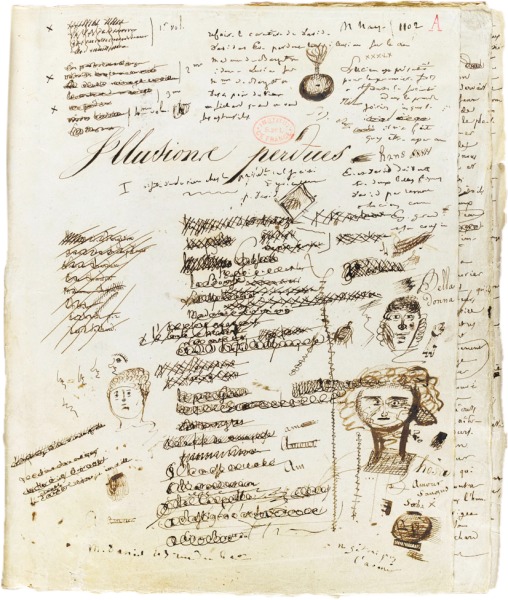From
Lost Illusions, Balzac
"Paper, an invention not less marvelous than the other dependent invention of printing, was known in ancient times in China. Thence by the unrecognized channels of commerce the art reached Asia Minor, where paper was made of cotton reduced to pulp and boiled."
Parchment had become so extremely dear that a cheap substitute was discovered in an imitation of the cotton paper known in the East as charta bombycina. The imitation, made from rags, was first made at Basel, in 1170, by a colony of Greek refugees, according to some authorities; or at Padua, in 1301, by an Italian named Pax, according to others. In these ways the manufacture of paper was perfected slowly and in obscurity; but this much is certain, that so early as the reign of Charles VI., paper pulp for playing-cards was made in Paris.
When those immortals, Faust, Coster, and Gutenberg, invented the Book, craftsmen as obscure as many a great artist of those times appropriated paper to the uses of typography.
In the fifteenth century, that naive and Lost Illusions, by Honore De Balzac 111 vigorous age, names were given to the various formats as well as to the different sizes of type, names that bear the impress of the naivete of the times; and the various sheets came to be known by the different watermarks on their centres; the grapes, the figure of our Saviour, the crown, the shield, or the flower-pot, just as at a later day, the eagle of Napoleon's time gave the name to the "double-eagle" size. And in the same way the types were called Cicero, Saint-Augustine, and Canon type, because they were first used to print the treatises of Cicero and theological and liturgical works. Italics are so called because they were invented in Italy by Aldus of Venice
.
 Manuscript page from Lost Illusions, photo © Bibliothèque de l’Institut de France
Manuscript page from Lost Illusions, photo © Bibliothèque de l’Institut de France
Before the invention of machine-made paper, which can be woven in any length, the largest sized sheets were the grand jesus and the double columbier (this last being scarcely used now except for atlases or engravings), and the size of paper for printers' use was determined by the dimensions of the impression-stone. When David explained these things to Eve, web-paper was almost undreamed of in France, although, about 1799, Denis Robert d'Essonne had invented a machine for turning out a ribbon of paper, and Didot-Saint-Leger had since tried to perfect it. The vellum paper invented by Ambroise Didot only dates back as far as 1780.
This bird's eye view of the history of the invention shows incontestably that great industrial and intellectual advances are made exceedingly slowly, and little by little, even as Nature herself proceeds. Perhaps articulate speech and the art of writing were gradually developed in the same groping way as typography and paper-making.
— "Rag-pickers collect all the rags and old linen of Europe," the printer concluded, "and buy any kind of tissue. The rags are sorted and warehoused by the wholesale rag merchants, who supply the paper-mills. To give you some idea of the extent of the trade, you must know, mademoiselle, that in 1814 Cardon the banker, owner of the pulping troughs of Bruges and Langlee (where Leorier de l'Isle endeavored in 1776 to solve the very problem that occupied your father), Cardon brought an action against one Proust for an error in weights of two millions in a total of ten million pounds' weight of rags, worth about four million francs! The manufacturer washes the rags and reduces them to a thin pulp, which is strained, exactly Lost Illusions, by Honore De Balzac 112 as a cook strains sauce through a tamis, through an iron frame with a fine wire bottom where the mark which give its name to the size of the paper is woven. The size of this mould, as it is called, regulates the size of the sheet.
[...]
— "The problem does not lie in the manufacturing process; it is a question of the first cost of the pulp. Alas, child, I am only a late comer in a difficult path. As long ago as 1794, Mme. Masson tried to use printed paper a second time; she succeeded, but what a price it cost! The Marquis of Salisbury tried to use straw as a material in 1800, and the same idea occurred to Seguin in France in 1801. Those sheets in your hand are made from the common rush, the arundo phragmites, but I shall try nettles and thistles; for if the material is to continue to be cheap, one must look for something that will grow in marshes and waste lands where nothing else can be grown. The whole secret lies in the preparation of the stems.
At present my method is not quite simple enough. Still, in spite of this difficulty, I feel sure that I can give the French paper trade the privilege of our literature; papermaking will be for France what coal and iron and coarse potter's clay are for England--a monopoly. I mean to be the Jacquart of the trade."













